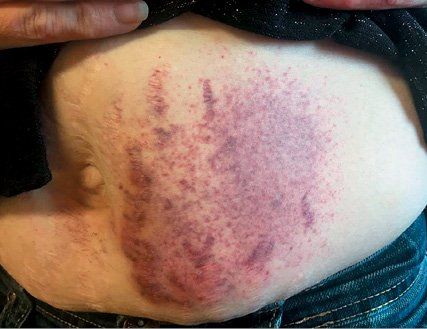Publication
Article
Psychiatric Times
Psychogenic Purpura
Psychogenic purpura is a rare and poorly understood syndrome. However, early recognition and intervention can lead to remissions which may last years.
Psychogenic Purpura

Presentation
A 32-year-old, white woman presented for psychiatric follow up with complaints of spontaneous bruising to the left upper and lower abdomen that had been present for the past 5 days in addition to routine psychiatric care for medication management of schizoaffective disorder, depressed type. She had reported previous episodes of bruising only to her primary care provider. She had been experiencing an increase in stress recently due to having to travel 26-hours round trip on multiple occasions because of divorce proceedings, and a custody dispute, which were taking place out of state. She was also completing her last semester in a bachelor’s degree program and was finding it difficult to balance everything.
The unexplained lesions were painful, but she denied any history of trauma. She reported multiple similar episodes in the past, all of which, on review, occurred during times of increased stress. She described the typical course of these lesions as experiencing pain for the first few days, which would resolve with the appearance of bruising that would last for 2 to 3 weeks. Previous workup by her primary care provider included complete blood count (CBC), complete metabolic panel (CMP), and imaging of affected sites, all of which were unremarkable.
Her medical history was significant for irritable bowel syndrome (IBS), polycystic kidney disease (PKD), and schizoaffective disorder. She had no new exposures or medications. Review of systems was negative for fever, headache, dizziness, epistaxis, nausea, vomiting, diarrhea, hematuria, arthralgia. Her family history was negative for bleeding or coagulation disorders. Surgical history was negative. Allergies to drugs included doxycycline, varenicline, promethazine, metoclopramide. Her medications included aripiprazole, lamotrigine, and prazosin for management of psychiatric symptoms and bentyl for management of irritable bowel syndrome (IBS).
Physical exam
The patient was a well-developed, well-nourished female without acute distress. She was alert and oriented. Her vitals were stable with blood pressure 110/73, pulse at 75 beats per minute, respiratory rate was 18 breaths per minute. Her body mass index (BMI) was in the normal range of 22.5. The patient’s head was normocephalic, atraumatic, and oral mucosa was pink and moist without mass, inflammation, or contusions. Her neck was supple without lymphadenopathy or mass, and her lungs were clear to auscultation bilaterally. Her heart had a regular rate and rhythm without murmur.
The abdominal exam revealed a soft, nondistended abdomen without tenderness except for superficial tenderness at the site of ecchymosis. Her skin showed a 12.5 × 15 cm. ecchymotic lesion to the left upper and lower quadrants of the abdomen which was mildly tender to palpation (Figure). Striae was present on the abdomen.
Psychiatric evaluation showed the patient was able to discern reality from psychosis. Her thought process was clear and linear with eye contact maintained. Her speech was fluent, and she demonstrated appropriate grooming. She endorsed auditory and visual hallucinations, which were stable and at baseline for her schizoaffective symptoms.
Lab testing included a CBC, CMP, and coagulation studies, all of which were unremarkable. The patient’s blood urea nitrogen and creatinine levels were also normal.
Psychogenic Purpura Facts
» There are fewer than 200 case reports of psychogenic purpura, also known as Gardner-Diamond syndrome or autoerythrocyte sensitization.
» The syndrome was named in 1968 after it was found to be psychologically based.
» Inherited bleeding disorders such as von Willebrand disease and factor XIII deficiency should be ruled out, and use of antiplatelet and anticoagulants should be considered in the differential.
» SSRIs, on rare occasions, can inhibit platelet function and may increase bleeding times.
» Malingering and factitious disorders should also be considered in the differential.
Discussion
Psychogenic purpura, also known as Gardner-Diamond syndrome or autoerythrocyte sensitization, is a very rare disorder with less than 200 specific case reports found, 126 of which are earlier than 2009.1,2 It is a poorly understood condition and is typically precipitated by psychological stress; however, autosensitization to phosphoglyceride of the erythrocyte membrane plays a role in the pathology.3–5 The syndrome was renamed to “psychogenic purpura” in 1968 after Ratnoff and Agle found the syndrome to be psychologically based.6
The condition presents with emotional distress followed by spontaneous occurrence of recurrent, painful ecchymosis and may have prodromal malaise and fatigue. The patient may experience burning, pain or itching that occur before the skin lesions appear.3 A few minutes later, induration occurs followed by edematous, pink lesions within 4 to 5 hours, which will become ecchymotic in the next 1 to 1.5 days. After the inflammation subsides, so does the pain. Lesions will change color from blue to green to yellow before eventually fading and resolving within 7 to 10 days.7
Systemic symptoms may include abdominal pain, nausea and vomiting, joint pain, and headache.8 It is most common among middle-aged women, particularly women with comorbid psychiatric illness.9 Because of the rarity of the condition, incidence and prevalence have not been reported.
Bruising may occur anywhere, however it is most common on the limbs and may present in several areas simultaneously.9 Active external bleeding may also occur such as epistaxis and GI bleeding and the condition is thought to be a potential cause of religious stigmata phenomena.10 Copper containing products, such as copper-containing IUDs may exacerbate symptoms.
Inherited bleeding disorders such as von Willebrand disease and factor XIII deficiency should be ruled out. Use of antiplatelet and anticoagulants such as aspirin and nonsteroidal anti-inflammatories should be considered in the differential.3 SSRIs, on rare occasions, can similarly inhibit platelet function and may increase bleeding times.10 Malingering and factitious disorders should also be considered in the differential. The purpuric lesions may be alarming, therefore psychogenic purpura should also be considered in the differential of suspected child abuse.4
There are no tests that specifically diagnose psychogenic purpura, however labs may be useful to rule out other causes of bleeding. Prothrombin time (PT) and partial thromboplastin time (PTT), CBC, von Willebrand panel, erythrocyte sedimentation rate (ESR) and antinuclear antibody (ANA) may be performed, but the results would be normal in psychogenic purpura.10 The patient’s own washed erythrocytes may be injected subcutaneously and if subsequent bruising develops, the diagnosis is supported; however, this theory has not been proven and this testing remains controversial.2,9 Serum creatinine can rule out platelet dysfunction due to uremia.10
In the case of the presenting patient, extensive records were available and reviewed. Other incidences of spontaneous bruising without identifiable trauma were documented with unremarkable labs, including CBC, CMP, folate, total iron binding capacity, and X rays. Often, psychologic and somatic disorders may initially present in primary care settings. These disorders may be difficult for primary care providers to evaluate and treat due to nonspecific symptoms that can vary greatly.
Patients with psychiatric conditions may feel their concerns are simply attributed to their psychiatric illness.11,12 This case demonstrates a typical course of the difficulties in diagnosing psychogenic purpura. Our patient had gone a number of years without a clear diagnosis or reason for her bruising. Assessing her current presentation with an extensive review of medical and psychiatric records where bruising was reported during times of major life stressors was key in determining the diagnosis. Collaboration between providers is often needed for accurate diagnosis and treatment of psychogenic disorders.
Treatment
There is no curative treatment for psychogenic purpura however the disease may have remissions and recurrences. Remission may occur through stress management, which is the main focus of treatment.9 Psychiatric treatment is most effective with higher treatment success rates associated with early treatment.3 Psychotherapy may help patients cope with the pain and cosmetic consequences of the condition.4
Pharmacologic management of symptoms has been tried with a variety of medications including glucocorticoids, pain medications, and hormonal contraceptives, which have been ineffective.6 Placebo effect may be used to help alleviate symptoms, however relief of acute stress and treatment of psychological factors is crucial for remission.3 Specific treatment guidelines do not exist, however treatments may include pain control with amitriptyline, gabapentin, or topical lidocaine as needed.4,9 SSRIs and serotonin and norepinephrine reuptake inhibitors may help treat comorbid psychiatric conditions; however, caution must be advised as these medications may, rarely, interfere with platelet function.4 Lesions are self-limited and may not require any treatment depending on severity.5 Relapses and remissions may be common with remissions potentially lasting for several years with management of stress and psychological factors. Recurrence around anniversaries of major life events is typical.3
Conclusion
Psychogenic purpura is a rare and poorly understood syndrome. Accurate diagnosis may prevent a lengthy and expensive workup, which is unnecessary. Interprofessional collaboration may be necessary for accurate diagnosis and treatment. Early recognition and intervention with appropriate psychological assessment and treatment can lead to remissions which may last years.3
Disclosures:
Ms. Sierra is a Physician Assistant and Assistant Professor, Idaho State University, Department of Physician Assistant Studies, Caldwell, ID; Ms. Brown is a Physician Assistant, Community Partnership of Idaho and Lifeways Behavioral Health of Oregon Affiliate Faculty, Idaho State University, Department of Physician Assistant Studies.
References:
1. Miranda JV, Vagner B. Gardner-Diamond Syndrome: A Literature Review. http://internalmedicine.imedpub.com/gardnerdiamonds-syndrome-literature-review.pdf. Accessed April 13, 2018.
2. Gardner FH, Diamond LK. Autoerythrocyte sensitization: a form of purpura producing painful bruising following autosensitization to red blood cells in certain women. Blood. 1955;10:675-690.
3. Jafferany M, Bhattacharya G. Psychogenic purpura (Gardner-Diamond syndrome). Prim Care Compan CNS Dis. 2015;17:10.4088.
4. Fried R. Psychogenic Purpura (Gardner-Diamond Syndrome, Autoerythrocyte Sensitization Syndrome, Painful Bruising Syndrome). https://goo.gl/6h252o. Accessed aPRIL 13, 2018.
5. Vivekanandh K, Dash G, Mohanty P. Gardner diamond syndrome: A psychogenic purpura. Indian Dermatol Online J. 2017;8:521-522.
6. Sarkar S, Ghosh SK, Bandyopadhyay D, Nath S. Psychogenic purpura. Indian J Psychiatry. 2013;55:192-194.
7. Ivanov O, Lvov A, Michenko A, et al. Autoerythrocyte sensitization syndrome (Gardner-Diamond syndrome): review of the literature. J Eur Acad Dermatol Venereol. 200923:499-504.
8. Meeder R, Bannister S. Gardner-Diamond syndrome: Difficulties in the management of patients with unexplained medical symptoms. Paediatrics & Child Health. 2006;11(7):416-419.
9. National Institutes of Health. Gardner-Diamond Syndrome. 2016. https://rarediseases.info.nih.gov/diseases/6481/gardner-diamond-syndrome. Accessed April 13, 2018.
10. Geisler, BP. Psychogenic purpura (Gardner-Diamond syndrome). Feb 10, 2017. https://www.uptodate.com/contents/psychogenic-purpura-gardner-diamond-syndrome. Accessed April 13, 2018
11. Mittal D, Ounpraseuth ST, Reaves C, et al. Providers’ Personal and Professional Contact With Persons With Mental Illness: Relationship to Clinical Expectations. Psych Serv. 2016;67:55-61.
12. Sullivan G, Mittal D, Reaves CM, et al. Influence of schizophrenia diagnosis on providers’ practice decisions. J Clin Psychiatry. 2015;76:1068-1074.





